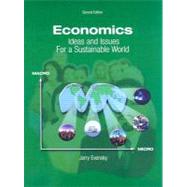“Imagine the best teacher you've ever had giving you a personal course in economics. That's Evensky's style – and accomplishment. His is an economics based solidly on the values of human flourishing, a humane and yet tough-minded approach to the Dismal Science.”
- Deirdre McCloskey, author of Economical Writing
Economics: Ideas and Issues for a Sustainable World guides students through the standard economic model from micro foundations to macro implication in a technically rich, accessible, and engaging presentation. It puts economics into a larger social and geopolitical context, including in-depth analysis of sustainability, globalization, and ethics in market systems.
This text has been designed to meet the needs of a growing market niche: Many economics departments are paring down the two-semester introductory sequence to a one-semester introductory course to make room for a richer array of upper-division electives. Thus, the one-semester intro course has become, for many, the basic theoretical frame students bring to the two-semester intermediate micro/macro sequence.
In just under 350 pages, Economics: Ideas and Issues for a Sustainable World lays a strong theoretical foundation with plenty of engagingapplications that stimulate students' interest in moving on to thattwo-semester intermediate sequence. It is written to be a one-semester
full theoretical development for systematic analysis of critical issues, helping students see the connection between economic analysis and social and political analysis, and how economics plays a role in unfolding historical events.
Features
- Integrates micro- and macroeconomic analysis into one text suitable for a one-semester introductory course
- Written in a voice that speaks to students, informed by the history of economic thought and using examples from economic history
- Designed for developmental learning, moving by steps from a simple to a complex, mature framework of analysis
- Sets economics analysis into larger social and political contexts, addressing issues like the role of social stereotyping, political power struggles, and ethics in market systems.
- Second edition includes new material throughout the text discussing issues involving globalization and sustainability
Chapter 1, Section 1.2.4 (pp.4-5)
Chapter 9, Section 9.3.14 (pp.147-48)
Chapter 12, Section 12.3.2 (pp.182-83)
Chapter 18, Section 18.2.6 (pp.264-67)
6. Final chapter on justice and liberal society includes discussions of the philosophical contributions of Adam Smith and John Stuart Mill








